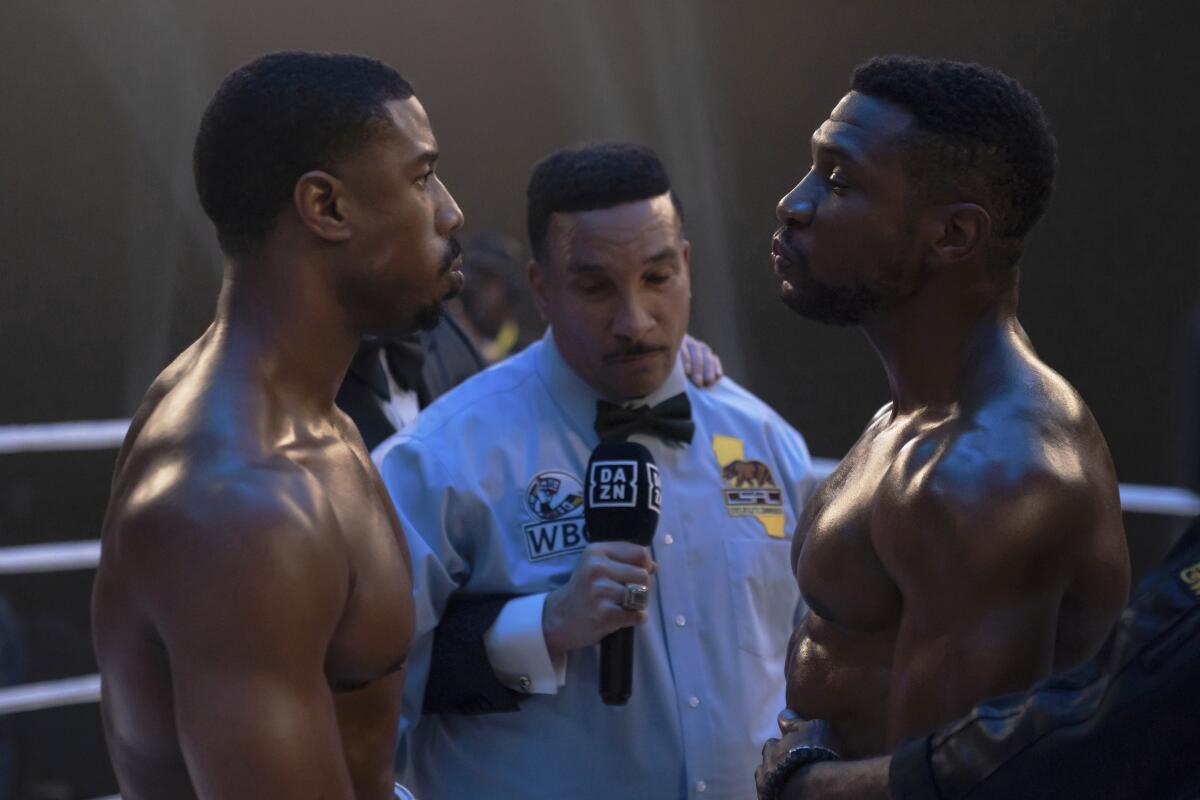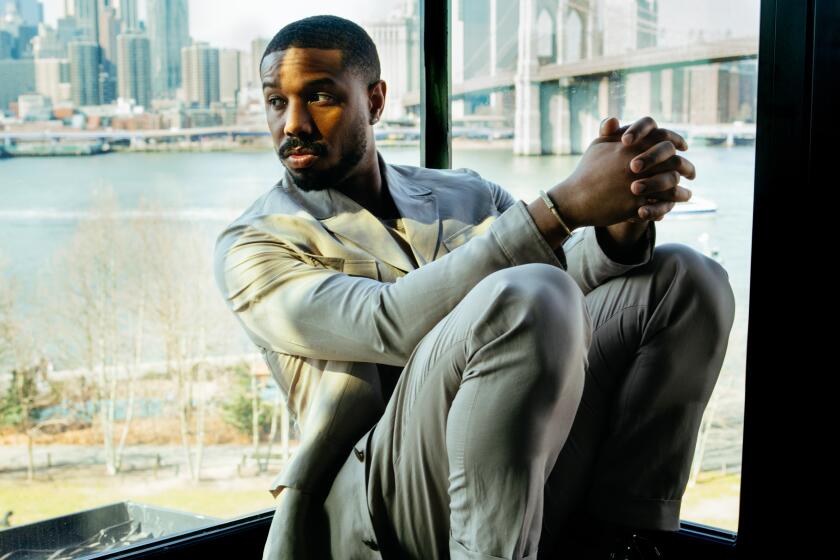Review: Michael B. Jordan is the one to fly now with âCreed IIIâ

For âCreedâ star Michael B. Jordan, stepping behind the camera for his directorial debut in âCreed IIIâ follows in the very famous footsteps of the original star of the franchise â Sylvester Stallone. After the critical success of âRocky,â for which he wrote the screenplay, Stallone took over from John G. Avildsen, to direct âRocky II,â which became a box office smash, cementing Stallone as an unlikely action star auteur. Hopefully, Jordan manages a similar trajectory with âCreed III,â a solid first feature with a knockout performance from Jonathan Majors.
Thereâs a meta element to Jordanâs move behind the camera that mimics Adonis Creedâs journey in the screenplay by Keenan Coogler and Zach Baylin. Adonis, a.k.a. Donnie (Jordan), has hung up the gloves and moved into a promoter role, supporting the championship aspirations of Felix Chavez (played by pro boxer JosĂŠ Benavidez), and spending time with his family, wife Bianca (Tessa Thompson) and daughter Amara (Mila Davis-Kent).
For your safety
The Times is committed to reviewing theatrical film releases during the COVID-19 pandemic. Because moviegoing carries risks during this time, we remind readers to follow health and safety guidelines as outlined by the CDC and local health officials.
The domestic challenges â finding his purpose outside of the ring, reckoning with the history of his relationship with his adopted mother (Phylicia Rashad) and learning to express himself with his wife â are fairly standard issue and not all that compelling beyond what the actors bring to the role. Where âCreed IIIâ really starts to stir to life is in the introduction of Jonathan Majors as a figure from Donnieâs dark and violent childhood.
Damian, a.k.a. Dame (Majors), was a big brother type to Donnie, and a rising star in boxing, but when a fight at a convenience store got out of hand, Donnie ran and Dame went to prison. Heâs turned up now, 18 years later, hooded and squirrelly after his years behind bars, but still chomping at the bit for his own chance at the belt. Donnieâs reluctant to back him but harbors guilt that his friend had his dream deferred, while his were fulfilled beyond his wildest dreams.
âCreed IIIâ makes good use of the inherent qualities in each of its leading men: Thereâs something rather sweet, innocent and noble in Jordanâs persona, which is put to good use as Donnie struggles to do the right thing, while Majors always seems like he has the weight of the world on his shoulders. There is something intrinsically sorrowful in Majorsâ countenance, and as Dame, he emanates a kind of wounded anger that makes him want to hurt someone, not âboxâ with focus and control.
Making his directorial debut with âCreed III,â the actor is diplomatic about his creative differences with Sylvester Stallone. But he stands by his vision.
If âCreed IIIâ tells us anything, it is that Majors is the heir apparent to Marlon Brando; his angry, resentful Dame, a bruiser with a chip on his shoulder, is in direct lineage from Brandoâs Terry Malloy in âOn the Waterfront.â Majors fully embodies the character, from his South-Central accent, his clipped cadence and hunched posture slowly unfurling as he becomes more confident and powerful, thanks to his own machinations and Donnieâs guilt-ridden enabling.
But while Dame is the far more fascinating character, Donnie is our hero, and the film proceeds as such, with dueling training montages and snowy white boxing shorts taking the symbolic place of a heroâs white cowboy hat. Coogler and Baylinâs screenplay isnât all that innovative with the sports movie formula, and it unfortunately tends to rely on characters plainly spelling out their inner monologues, rather than leaving it to subtext.
But Jordanâs steady direction elevates the material, keeping a strong hand on the tone and emotional tenor. Cinematographer Kramer Morgenthau (who also shot âCreed II,â directed by Steven Caple Jr.) brings fluid camera movements and an appealing use of practical lighting, imbuing the film with motion and texture. Jordan takes a big creative swing during a climactic title match, experimenting with a subjective fantasy sequence. It doesnât entirely pay off, but itâs nice to see him color outside of the lines with the risky maneuver.
But what Jordan does best as star, director and producer is showcase Majorsâ heavyweight performance, cementing him as one of our brightest stars. Taking over a behind-the-scenes role is a part of the âRockyâ legacy, and Jordan takes the reins with ease, championing Majors and heralding an exciting new chapter of his career, beyond âCreed.â
Katie Walsh is a Tribune News Service film critic
âCreed IIIâ
Rated: PG-13, for intense sports action, violence and some strong language
Running time: 1 hour, 56 minutes
Playing: Starts March 3 in general release
More to Read
Only good movies
Get the Indie Focus newsletter, Mark Olsen's weekly guide to the world of cinema.
You may occasionally receive promotional content from the Los Angeles Times.











